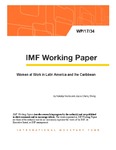Please use this identifier to cite or link to this item:
http://thuvienso.quochoi.vn/handle/11742/39079Full metadata record
| DC Field | Value | Language |
|---|---|---|
| dc.creator | Natalija Novta, Joyce Cheng Wong | - |
| dc.date.issued | February 2017 | - |
| dc.identifier.uri | http://hdl.handle.net/11742/39079 | - |
| dc.description.abstract | Women across the world remain an underutilized resource in the labor force. Participation in the labor force averages around 80 percent for men but only 50 percent for women – nearly half of women’s productive potential remains untapped compared to one-fifth for men. Latin America and the Caribbean (LAC), as a region, saw the largest gains in female labor force participation (LFP) in the world during the last two decades. Women in LAC are becoming increasingly active in paid work, closing the gap with men and catching up to their counterparts in advanced economies at an impressive rate. In this paper, we document the recent trends in female LFP and female education in the LAC region, discuss the size of potential gains to GDP from increasing female LFP and policies which could be deployed towards this goal. | - |
| dc.language | en | vi |
| dc.publisher | International Monetary Fund | vi |
| dc.rights | International Monetary Fund | vi |
| dc.subject | Economics of gender | vi |
| dc.subject | Women’s labor supply | vi |
| dc.subject | Public policy affecting female LFP | vi |
| dc.title | Women at Work in Latin America and the Caribbean | vi |
| dc.type | Báo cáo | vi |
| dc.source.method | International Monetary Fund | - |
| Appears in Collections: | Phân quyền - Vấn đề xã hội | |
Files in This Item:
Items in DSpace are protected by copyright, with all rights reserved, unless otherwise indicated.

THƯ VIỆN QUỐC HỘI - VĂN PHÒNG QUỐC HỘI
Địa chỉ: Nhà Quốc Hội, Đường Độc Lập, Ba Đình, Hà Nội
Điện thoại: 080.41947
Email: thuvienquochoi@quochoi.vn




